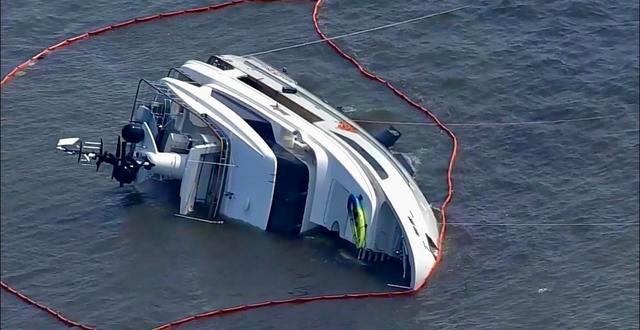$8 Million Yacht Capsizes Near Annapolis: What Happened and What’s Next?
Paris Hilton Launches PureWow: A New Era of Lifestyle and Content Creation

On Saturday, a 122-foot yacht capsized on Maryland’s Rhode River, forcing the crew to abandon ship. At about 1230 hours on Saturday, the U.S. Coast Guard received a distress call from the 2010-built yacht Lovebug
Introduction
The yachting community was stunned by the recent news of an $8 million luxury yacht capsizing near Annapolis, Maryland. This unfortunate incident has raised numerous questions regarding safety protocols, weather conditions, and the potential consequences for the maritime industry. In this article, we will explore the details surrounding the incident, the possible causes, and what steps might be taken to prevent such occurrences in the future.
Overview of the Incident
What Happened?
The capsize occurred when the vessel, a high-end luxury yacht known for its state-of-the-art design and cutting-edge technology, suddenly lost stability and tipped over. The incident took place near the coastal waters of Annapolis, a region well-known for its vibrant boating culture and sailing activities.
According to eyewitness reports, the yacht encountered rough waters unexpectedly. Despite being a modern vessel equipped with advanced safety mechanisms, it was unable to withstand the adverse conditions and ultimately capsized. Fortunately, all passengers and crew members aboard were safely rescued, thanks to the swift response of the Coast Guard and nearby boats.
Impact on the Yachting Community
The news of the $8 million yacht capsizing has sent shockwaves through the yachting community. Owners of similar vessels and prospective buyers are concerned about the reliability and safety of these luxury yachts, particularly when navigating unpredictable waters. Industry experts are now scrutinizing the build quality and safety features of high-end yachts to identify any potential flaws that could have contributed to the incident.
Possible Causes of the Capsizing
Weather Conditions
One of the primary factors being investigated is the weather at the time of the incident. The Chesapeake Bay area, where Annapolis is located, is known for its rapidly changing weather patterns. Sudden gusts of wind, high waves, and choppy waters could have played a significant role in destabilizing the yacht.
Structural Design
Another area of investigation is the structural design and engineering of the yacht. Despite its high price tag and reputation for luxury, there may have been a design flaw or imbalance in weight distribution that caused the vessel to capsize. Stability and balance are crucial aspects of yacht design, and even a minor miscalculation can lead to catastrophic results.
Human Error
While modern yachts come with sophisticated navigation systems and safety features, human error cannot be ruled out. The experience and decision-making capabilities of the captain and crew during challenging conditions are being examined to determine whether any misjudgments or lapses contributed to the incident.
Rescue Efforts and Response
Coast Guard and Local Assistance
The response to the incident was swift and efficient. The U.S. Coast Guard, along with local rescue teams and nearby boaters, quickly arrived at the scene to assist in the rescue operations. All passengers and crew members were safely evacuated from the capsized yacht. Their timely actions prevented what could have been a tragic loss of life.
Salvage Operations
Efforts are currently underway to salvage the $8 million yacht. Specialized equipment and teams have been deployed to recover the vessel and minimize environmental impact. The recovery process is expected to be complex and costly due to the yacht’s size, weight, and the challenging underwater conditions in the Chesapeake Bay.
Legal and Financial Ramifications
The capsize of such an expensive yacht has significant legal and financial implications. Insurance claims, liability disputes, and potential lawsuits are likely to arise as the investigation progresses.
Insurance Considerations
Given the yacht’s high value, insurance claims will play a critical role in covering the losses. However, insurance companies will conduct their own investigations to determine whether the capsize was due to negligence, design flaws, or uncontrollable natural factors. This could impact the payout amount and the speed at which claims are settled.
Owner’s Perspective
For the owner of the yacht, the incident is not only a financial loss but also an emotional setback. Investing in a multi-million-dollar vessel comes with the expectation of reliability and safety. The owner may pursue legal action against the manufacturer or any other parties found responsible for the incident.
Industry Reactions and Future Implications
The luxury yacht industry is closely watching the developments surrounding this incident. Manufacturers, designers, and safety experts are reassessing current standards and protocols to prevent similar occurrences in the future.
Stricter Safety Regulations
There may be a push for stricter safety regulations and more rigorous testing procedures for yachts, especially high-end models that promise luxury without compromising safety. Changes in design standards, safety equipment, and crew training requirements could be implemented to enhance overall safety.
Consumer Confidence
Incidents like this can shake consumer confidence in the high-end yacht market. Potential buyers may become more cautious and demand more transparency regarding the safety and stability features of vessels before making a purchase.
Conclusion
The capsize of the $8 million yacht near Annapolis is a stark reminder of the inherent risks involved in yachting. While the exact cause of the incident is still under investigation, it highlights the need for continuous improvements in safety standards, design engineering, and preparedness for unexpected conditions. As the industry takes lessons from this unfortunate event, it is hoped that future yachts will be equipped to handle similar challenges more effectively.



